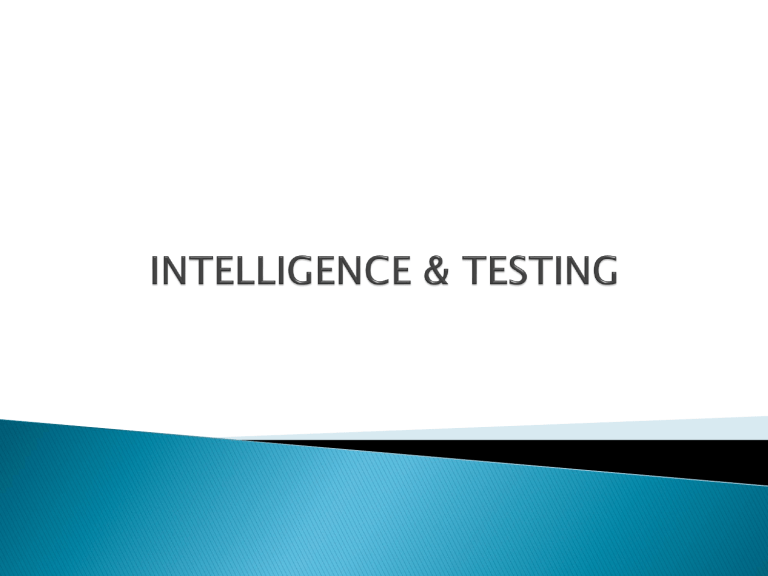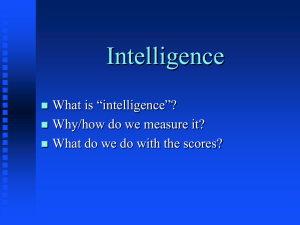intelligence powerpoint

PSYCHOMETRICIANS: develop tests
-try to make constructs measurable and quantifiable
-purpose is to differentiate between testtakers
3 Qualities of Tests:
1. Standardized
2. Reliable
3. Valid
-administered the same every time, to every person
-so can compare scores among test-takers
-NORMS: established scores
-usually graded on normal curve-compares you to others performance
-STANDARDIZATION SAMPLE: representative sample of test takers who establish norms
-consistent scores
Ways to measure:
-Test-retest reliability: take the same test, high positive correlation between scores
-Split-half reliability: score on half is correlated with score on other half
-Equivalent-form reliability: score on 2 different versions of a test have high correlation
-accuracy, measures what it is supposed to
Ways to measure:
-Content validity: measures all of the skills/knowledge it’s supposed to
-Criterion-related validity: test correlates with other ways to measure what’s being tested
-Predictive validity: how well it measures a future result
-Construct validity: how well it measures the construct for which it is designed
-is a construct, so hard to define
-can only be defined by the behaviors that indicate intelligence, usually what enables success in that culture
-is intelligence one underlying capacity or is it different abilities?
http://upload.wikimedia.org/wikipedia/commons/thumb/e/ec/Men_in_Paris_park_pl aying_chess.jpg/640px-Men_in_Paris_park_playing_chess.jpg
one important factor underlies all intelligence g : general intelligence
-used factor analysis: statistical technique that finds correlations between different items to narrow down items
-high degree of correlation between all mental tasks= one factor
-disagreed
-used factor analysis with college students
-7 primary mental abilities:
1.
Inductive reasoning
2.
Word fluency
3.
Perceptual ability
4.
Verbal comprehension
5.
Spatial visualization
6.
Numerical ability
7.
Associative memory
2 factors of intelligence:
1. Crystallized intelligence: learned knowledge over time (vocabulary, facts) that increases with age
2. Fluid intelligence: ability to solve problems and pick up skills (puzzles) that tends to decrease with age
8 specific intelligences
-represent different independent abilities
-broadens traditional definition of intelligence
-savants: with exceptional skills show intelligence is not single factor http://commons.wikimedia.org/wiki/File:Multipleints.jpg
-highest IQ not always=success
-interpersonal skills: ability to get along and be thoughtful of others
-intrapersonal skills: understand self and have self-control, and delay of gratification
3 types of intelligences
Analytical intelligence: traditional abilities
Creative intelligence: think in new ways
Practical intelligence:
“street smarts”
-must try to make intelligence concrete
-way to assess mental aptitudes and compare them with others numerically http://upload.wikimedia.org/wikipedia/commons/2/21/Bundesarchiv_Bild_10
2-11344%2C_Intelligenzpr%C3%BCfung_schulentlassener_M%C3%A4dchen.jpg
-created 1 st intelligence test
-compulsory public education in France at turn of the 20 th century
-needed to identify students who would need special attention
-created test to measure Mental age: abilities should have for chronological age http://commons.wikimedia.org/wiki/File:Alfred_Binet.jpg
Louis Terman: professor at Stanford revised
Binet’s test
IQ=intelligence quotient
IQ=
mental age
x
100 chronological age
-most commonly used IQ tests today
-measured on deviation IQ
-compared to others taking the test
-100=average IQ
-68%=85-115
-95%=70-130
-99%=55-145
FLYNN EFFECT:
Increasing IQ, means must restandardize http://commons.wikimedia.org/wiki/File:Standard_deviation_diagram.svg
-both are important in intelligence
Nature:
-MZ twins, even separated at birth, have very similar IQs
-heritability: extent to which trait is inherited is
50-75%
Nurture:
Flynn Effect: increasing IQs over 3 generations
-school, better nutrition, technology, other environmental factors
-racial groups score differently on tests
-bias because of differing environmental factors
Stereotype threat: anxiety that is created when one is worried that they will confirm a negative stereotype about one’s group




